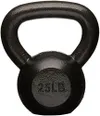
Russian kettlebell swings and American kettlebell swings are bulletproof full-body exercises for building strength and explosive power, but have you tried the resistance band variation yet?
Learning how to do kettlebell swings is fundamental to exercising with kettlebells, and there are many variations to choose from when programming kettlebell workouts. One of my latest favorites is the resistance band kettlebell swing, which piles on the resistance to an already challenging kettlebell strength and conditioning exercise.
Grab one of the best kettlebells for weightlifting, and check out how to do it, the benefits and the muscles worked.
What is the banded kettlebell swing?

As the name suggests, you’ll add a resistance band to your kettlebell swing, increasing overall intensity and resistance. The best resistance bands come in varying thicknesses, so you could aim for the least or most resistance, depending on your ability.
Banded kettlebell swings seriously ramp up the difficulty of the standard swing, regardless of your chosen band, so remember that good form is paramount to staying safe. I recommend sharpening your swing form before adding a band to this exercise.
What is a kettlebell swing good for?
Kettlebell swings train explosive power using a hip hinge movement. The exercise builds strength in the upper and lower body while strengthening your core. Moreover, it’s a high-intensity kettlebell move, allowing you to tap into several components of fitness, including strength, power and cardio.
Like a deadlift, swings utilize the hip hinge position, working muscles along the back body, known as the posterior chain, including the lower back, glutes and hamstrings. You’ll also work your core muscles, hip flexors, and upper body, including the arms, delts and traps.
Get instant access to breaking news, the hottest reviews, great deals and helpful tips.
When performing American kettlebell swings, you engage much more of the upper body to shelve the weight in the overhead position, switching on those smaller stabilizer muscles in your shoulders, back and core network to help you control the weight.
The “swing” part of the movement is initiated by the hip hinge and thrust — not your arms. Rather than pulling the bell up with your upper body, drive it up using the powerhouse muscles — the glutes, legs, hips and core. This isn’t a squat, so maintain a soft knee bend without bending your knees too much.
How to do the banded kettlebell swing
- Stand with your feet shoulder-width apart and a kettlebell in front of you
- Double-wrap the band and thread it through the handle, then pass one end of the band through the loop to secure it
- Take the two parts of the band that are secured on the handle, and slide them to the bottom of the kettlebell on either side
- Place the length of the band on the ground horizontally, then step your feet through the band to secure it, and position the top of the band over your feet. Your feet should be roughly shoulder-width apart
- Bend your knees, grasp the kettlebell with two hands and stand
- To initiate the swing: pre-tension your core and glutes, softly bend the knees, then hinge forward at your hips and send the kettlebell back between your legs
- Keep your back flat and shoulders pulled back and down as you send your bum backward
- Swing the bell upwards and snap your hips forward, keeping tension through your glutes and core
- Keep a bend in the elbows and swing the bell to shoulder height (Russian swing) or overhead (American swing)
- Fully extend at the knees and hips as you stand. Pause for a moment, then control the bell downward and back between your legs for one rep.
Avoid leaning back at the top of the movement, as you’ll put too much pressure on your lower back. Keep the weight evenly distributed through your feet. Kettlebell beginners should also consider learning the fundamental grips (read: how to hold a kettlebell properly) first to get an understanding of how varying hand positions affect the emphasis on your muscle groups.
Even using a light band, you’ll need even more control over the bell as you punch through the resistance on the way up. Practice 3-5 sets of 8-12 reps and adjust the band accordingly.
More from Tom's Guide
Ready to try more kettlebell swing variations?
- I did 70 single-arm kettlebell swings every day for one week, here's what happened
- I did 90 American kettlebell swings a day for a week, here's what happened
- I did 90 lateral kettlebell swings every day for a week, here's what happened

Sam Hopes is a level 3 qualified trainer, a level 2 Reiki practitioner and fitness editor at Tom's Guide. She is also currently undertaking her Yoga For Athletes training course.
Sam has written for various fitness brands and websites over the years and has experience across brands at Future, such as Live Science, Fit&Well, Coach, and T3.
Having coached at fitness studios like F45 and Virgin Active and personal trained, Sam now primarily teaches outdoor bootcamps, bodyweight, calisthenics and kettlebells.
She also coaches mobility and flexibility classes several times a week and believes that true strength comes from a holistic approach to training your body.
Sam has completed two mixed doubles Hyrox competitions in London and the Netherlands and finished her first doubles attempt in 1:11.








